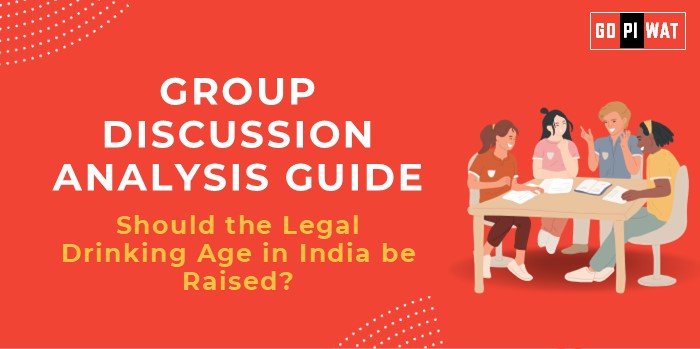📋 Group Discussion Analysis Guide: Should the Legal Drinking Age in India be Raised?
🌐 Introduction to the Topic
- 📜 Opening Context: India’s legal drinking age varies across states, ranging from 18 to 25. This diversity raises debates about the effectiveness of age restrictions in curbing alcohol misuse and promoting public health.
- 📖 Topic Background: Globally, higher drinking ages, such as 21 in the U.S., are associated with reduced alcohol-related harm. In India, alcohol consumption has grown significantly, particularly among the youth, prompting a reassessment of existing legal frameworks. Recent health and safety statistics add urgency to this discussion.
📊 Quick Facts and Key Statistics
- 🔢 Current Legal Age Range: 18-25 years, depending on the state.
- 🍺 Youth Consumption: 62% of Indian youth aged 18-24 consume alcohol occasionally (WHO, 2022).
- ⚠️ Alcohol-Related Deaths: Over 3 lakh deaths annually due to alcohol misuse (Indian Medical Association, 2023).
- 💰 Economic Impact: Alcohol contributes ₹1.75 lakh crore in tax revenue annually but costs ₹2.5 lakh crore in healthcare and lost productivity (NITI Aayog, 2024).
- 🌍 International Comparison: The U.S. and Japan, with a legal age of 21 and 20 respectively, report fewer alcohol-related accidents among youth.
👥 Stakeholders and Their Roles
- 🏛️ Government: Legislates and enforces drinking age laws while balancing health and revenue concerns.
- 🏥 Health Organizations: Advocate for stricter age limits to reduce public health risks.
- 🍷 Alcohol Industry: Opposes restrictive laws, citing economic and employment impacts.
- 🧑🤝🧑 Citizens and Youth Groups: Express varied opinions on personal freedom versus societal norms.
- 🌐 Global Bodies: WHO and similar organizations provide research and recommendations on alcohol policy.
🏆 Achievements and Challenges
✨ Achievements
- 💸 Revenue Generation: Alcohol taxes contribute significantly to state budgets.
- 📢 Improved Awareness: Campaigns have reduced underage drinking in states with stricter enforcement.
- 📉 Health Advocacy Success: Some states, like Kerala, have seen reduced alcohol abuse through partial bans and higher age limits.
⚠️ Challenges
- 🚔 Enforcement Gaps: Many states fail to enforce legal age limits effectively.
- 🕊️ Cultural Norms: Alcohol consumption is deeply rooted in various traditions, complicating policy.
- 📉 Economic Dependency: States heavily reliant on alcohol taxes resist stricter laws.
Global Comparisons:
• United States: Drinking age of 21 reduced accidents and hospitalizations among youth.
• France: Struggles with underage binge drinking despite strict policies.
Case Studies:
• Kerala: Increased drinking age from 21 to 23, observing a drop in youth-related alcohol incidents.
• Bihar: Implemented prohibition with mixed results—reduced consumption but increased illicit trade.
📢 Structured Arguments for Discussion
- 💬 Supporting Stance: “Raising the drinking age will align India with global best practices, reducing youth alcohol dependency and related societal costs.”
- 🗣️ Opposing Stance: “Raising the age might encourage illicit trade and underground drinking culture, defeating its purpose.”
- ⚖️ Balanced Perspective: “While raising the drinking age can bring health benefits, its success depends on strict enforcement and cultural shifts.”
📈 Effective Discussion Approaches
- 💡 Opening Approaches:
- “With over 3 lakh alcohol-related deaths annually, stricter age laws are a logical step.”
- “The U.S. reduced accidents by raising its drinking age to 21—India can achieve similar outcomes.”
- 💡 Counter-Argument Handling:
- “Illicit trade concerns can be mitigated through tighter enforcement and public awareness campaigns.”
- “Economic losses due to healthcare costs outweigh revenue benefits from alcohol taxation.”
📊 Strategic Analysis of Strengths and Weaknesses
Strengths
- 🩺 Proven health benefits in reducing youth harm.
- 🌍 Global precedent for raising drinking age.
Weaknesses
- 🚔 Poor enforcement of existing laws.
- 📉 Heavy reliance on alcohol revenues by states.
Opportunities
- 👩🎓 Build a health-conscious youth population.
- 🌎 Align with global standards in public health policy.
Threats
- ⚠️ Growth of black-market alcohol trade.
- 🤝 Public resistance to stricter laws.
🎓 Connecting with B-School Applications
- 💡 Real-World Applications:
- Policy analysis projects focusing on health and economy.
- Public health projects examining alcohol-related impacts.
- Exploring ethical business strategies within the alcohol industry.
- 💡 Sample Interview Questions:
- “How would you propose balancing economic and health priorities in alcohol policies?”
- “Can public-private partnerships help enforce stricter drinking laws effectively?”
- 💡 Insights for Students:
- Focus on enforcement strategies as case studies for public policy discussions.
- Explore economic implications of health-driven laws.


